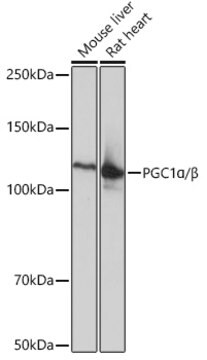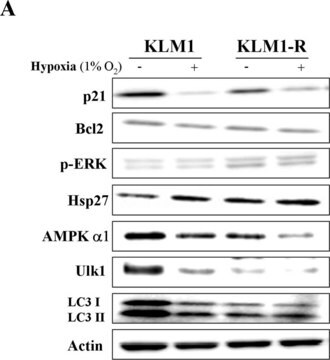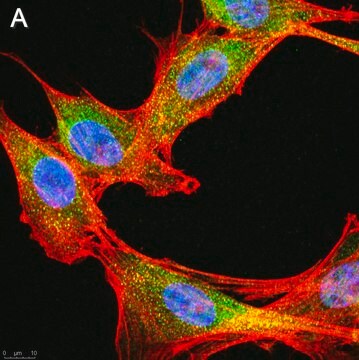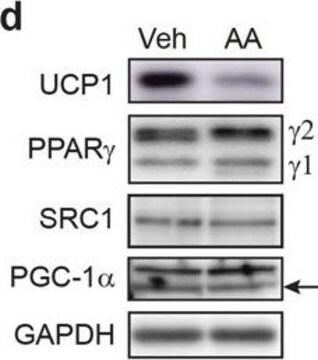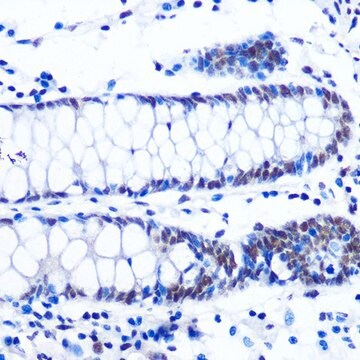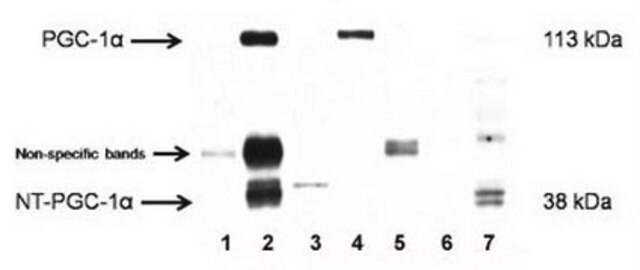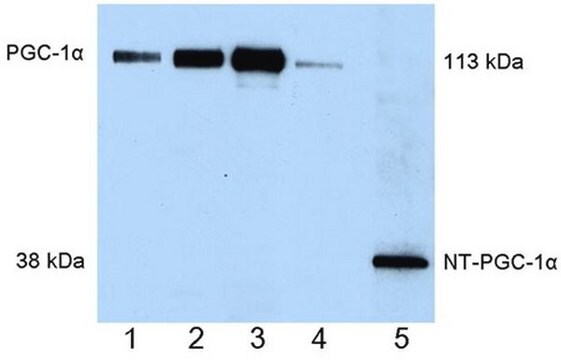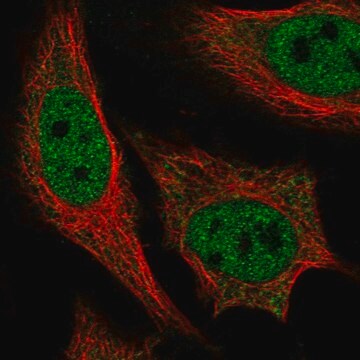おすすめの製品
由来生物
rabbit
品質水準
抗体製品の状態
affinity isolated antibody
抗体製品タイプ
primary antibodies
クローン
polyclonal
精製方法
affinity chromatography
化学種の反応性
mouse, human
化学種の反応性(ホモロジーによる予測)
rat (based on 100% sequence homology), porcine (based on 100% sequence homology), bovine (based on 100% sequence homology)
包装
antibody small pack of 25 μg
テクニック
immunocytochemistry: suitable
western blot: suitable
NCBIアクセッション番号
UniProtアクセッション番号
輸送温度
ambient
ターゲットの翻訳後修飾
unmodified
遺伝子情報
human ... PPARGC1A(10891)
詳細
Peroxisome proliferator-activated receptor gamma coactivator 1-alpha (UniProt: O70343; also known as PGC-1-alpha, PPAR-gamma coactivator 1-alpha, PPARGC-1-alpha) is encoded by the Ppargc1a (also known as Pgc1, Pgc1a, Ppargc1) gene (Gene ID: 19017) in murine species. PGC-1 alpha is a member of a family of transcription coactivators that plays a central role in the regulation of cellular energy metabolism. It is a homooligomeric transcriptional coactivator for steroid receptors and nuclear receptors that greatly increases the transcriptional activity of PPARG and thyroid hormone receptor on the uncoupling protein promoter. It is expressed in muscles, liver, kidney, brown adipose tissue, heart, and brain. It can regulate key mitochondrial genes that contribute to the program of adaptive thermogenesis and is also reported to play an essential role in metabolic reprogramming in response to dietary availability through coordination of the expression of a wide array of genes involved in glucose and fatty acid metabolism. PGC-1 alpha is known to induce the expression of PPARGC1- and ESRR-induced regulator, muscle 1 (PERM1) in the skeletal muscle in an estrogen-related receptors, -alpha (ESRRA)-dependent manner. PGC-1 alpha is significantly induced in brown adipose tissue and skeletal muscle by exposure to cold and is also shown to be up-regulated in brown adipose tissue of obese leptin-deficient (ob/ob) and leptin-unresponsive (db/db) mice. PGC-1 alpha is also required for oscillatory expression of clock genes, such as ARNTL/BMAL1 and NR1D1, through the co-activation of RORA and RORC, and metabolic genes, such as PDK4 and PEPCK.
特異性
This rabbit polyclonal antibody detects PGC-1 alpha in human and murine adipose tissue. it targets an epitope within 21 amino acids from the C-terminus region.
免疫原
Epitope: C-terminus
KLH-conjugated linear peptide corresponding to 21 amino acids from the C-terminus region of murine PPAR-gamma coactivator 1-alpha.
アプリケーション
Research Category
エピジェネティクス及び核内機能分子
エピジェネティクス及び核内機能分子
Anti-PGC-1 alpha, Cat. No. ABE868, is a highly specific rabbit polyclonal antibody that targets Peroxisome proliferator-activated receptor gamma coactivator 1-alpha and has been tested for use in Immunocytochemistry and Western Blotting.
Immunocytochemistry Analysis: A 1:500 dilution from a representative lot detected PGC-1 alpha in A431, HUVEC, and NIH/3T3 cells.
品質
Evaluated by Western Blotting in human brown adipose tissue lysate.
Western Blotting Analysis: 2 µg/mL of this antibody detected PGC-1 alpha in 10 µg of human brown adipose tissue lysate.
Western Blotting Analysis: 2 µg/mL of this antibody detected PGC-1 alpha in 10 µg of human brown adipose tissue lysate.
ターゲットの説明
~100 kDa observed; 90.59 kDa calculated. Uncharacterized bands may be observed in some lysate(s).
物理的形状
Affinity Purified
Purified rabbit polyclonal antibody in buffer containing 0.1 M Tris-Glycine (pH 7.4), 150 mM NaCl with 0.05% sodium azide.
保管および安定性
Stable for 1 year at 2-8°C from date of receipt.
その他情報
Concentration: Please refer to lot specific datasheet.
免責事項
Unless otherwise stated in our catalog or other company documentation accompanying the product(s), our products are intended for research use only and are not to be used for any other purpose, which includes but is not limited to, unauthorized commercial uses, in vitro diagnostic uses, ex vivo or in vivo therapeutic uses or any type of consumption or application to humans or animals.
適切な製品が見つかりませんか。
製品選択ツール.をお試しください
保管分類コード
12 - Non Combustible Liquids
WGK
WGK 1
引火点(°F)
does not flash
引火点(℃)
does not flash
適用法令
試験研究用途を考慮した関連法令を主に挙げております。化学物質以外については、一部の情報のみ提供しています。 製品を安全かつ合法的に使用することは、使用者の義務です。最新情報により修正される場合があります。WEBの反映には時間を要することがあるため、適宜SDSをご参照ください。
Jan Code
ABE868-25UG:
ABE868:
試験成績書(COA)
製品のロット番号・バッチ番号を入力して、試験成績書(COA) を検索できます。ロット番号・バッチ番号は、製品ラベルに「Lot」または「Batch」に続いて記載されています。
この製品を見ている人はこちらもチェック
Zhen-Hua Wang et al.
Frontiers in pharmacology, 12, 671563-671563 (2021-06-01)
Lack of vascularization is directly associated with refractory wound healing in diabetes mellitus (DM). Enrichment of endothelial precursor cells (EPCs) is a promising but challenging approach for the treatment of diabetic wounds. Herein, we investigate the action of nicotinamide riboside
Xuan Xu et al.
Cardiovascular diagnosis and therapy, 10(3), 453-469 (2020-07-23)
Myocardial mitochondrial dysfunction is the leading cause of chronic heart failure (CHF). Increased reactive oxygen species (ROS) levels, disruption of mitochondrial biogenesis and mitochondrial Ca2+([Ca2+]m) homeostasis and reduction of the mitochondrial membrane potential (ΔΨm) cause myocardial mitochondrial dysfunction. Therefore, treating
ライフサイエンス、有機合成、材料科学、クロマトグラフィー、分析など、あらゆる分野の研究に経験のあるメンバーがおります。.
製品に関するお問い合わせはこちら(テクニカルサービス)